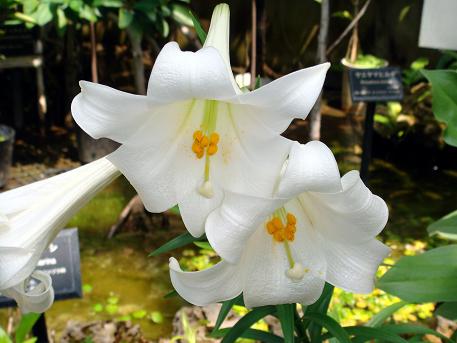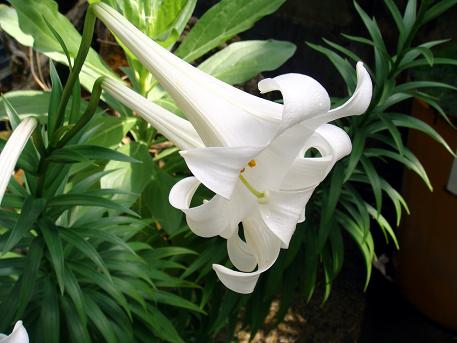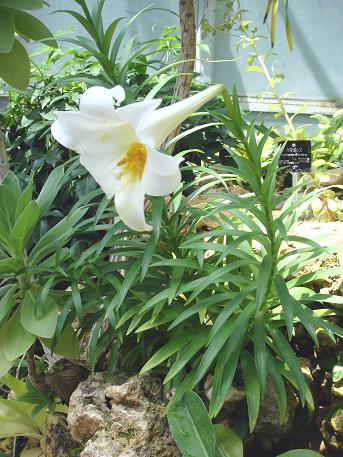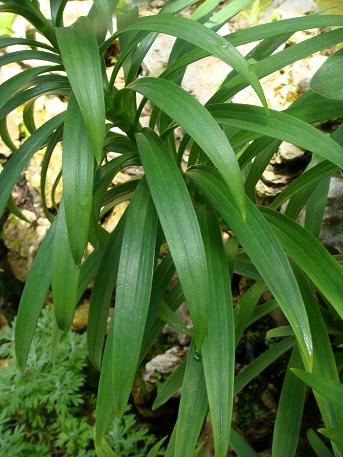| Family |
Liliaceae |
| Subfamily |
Lilioideae |
| Tribe |
Lilieae |
| Scientific name |
Lilium longiflorum Thunberg |
| Synonyms |
Lilium longiflorum Thunberg var. longiflorum |
| Common name |
(Japanese common name) teppou-yuri (テッポウユリ, 鉄砲百合 [meaning: gun lily]) |
| (English common name) Easter lily, trumpet lily, white trumpet lily |
| Distribution |
(Japan) Okinawa |
| (Other nations) none |
| Habitat |
Rock wall near seaside |
| Chromosomal number |
2n=24 |
| Description |
Plants electing 50-100cm tall. Leaves 10-18cm long, 5-15mm wide. Flowers
white perianths each 12-16cm long, flowering in April to June. Fruits 6-9cm
long. Perennial plants. |
| Reference |
Lilium longiflorum Thunb. |
| Lilium longiflorum Thunb. var. longiflorum |
| Use of Longitudinally Bisected Pistils of Lilium longiflorum for Studies on Self-Incompatibility |
| Process for storing and recovering plant tissue (US Patent 4052817/1977) |
| Composition for increasing yield of pulse (US Patent 4095973/1978) |
| Process for mass propagation of plantlets (US Patent 4338745/1982) |
| Fluorometirc enzyme inhibition immunoassay for measuring potency of allergen extracts (US Patent 4528267/1985) |
| Lily processes (US Patent 4570379/1986) |
| Lily products (US Patent 4604824/1986) |
| Stable allergenic extracts and methods (US Patent 4716120/1987) |
| Method of treating pineapples to inhibit opening of the pineapple flowers (US Patent 4834790/1989) |
| Fluorometric assay of allergic reactions (US Patent 4845027/1989) |
| Assaying allergen specific IgE levels with fluorogenic enzyme labeled antibody (US Patent 4849337/1989) |
| Culturing apparatus (US Patent 4951415/1990) |
| Self incompatibility protein (US Patent 5037959/1991) |
| Self-incompatibility gene (US Patent 5053331/1991) |
| Process for the production of lilium species (US Patent 5058318/1991) |
| Method for producing lilium elegans (US Patent 5138794/1992) |
| Process for producing plantlets whereby the formation of a cell mass is induced (US Patent 5413929/1995) |
| Protein tyrosine kinase A6 (US Patent 5573935/1996) |
| Method of hybrid crop production using dehydrated pollen from storage (US Patent 5689914/1997) |
| Process for the purification of aqueous extracts containing allergenically active proteins, extracts obtainable according to this process as well as their use (US Patent 5770698/1998) |
| DNA ligase assay (US Patent 5976806/1999) |
| Apparatus for the preparation of multiple pollen samples for cryogenic preservation (US Patent 6146884/2000) |
| Compositions and methods for production of male-sterile plants (US Patent 6403352/2002) |
| Methods and compositions utilizing Rad51 (US Patent 6391564/2002) |
| Efficient process for bulb and flower production (US Patent 6401386/2002) |
| Cultured plant cell gums for food, pharmaceutical, cosmetic and industrial applications (US Patent 6350594/2002) |
| Expression cassette and plasmid for strong constitutive gene expression and the use thereof (US Patent 6664387/2003) |
| Genetic transformation method for zoysiagrass (US Patent 6646185/2003) |
| Cathepsin V-like polypeptides (US Patent 6783969/2004) |
| Methods of and compositions for inhibiting the proliferation of mammalian cells (US Patent 7101839/2006) |
| Genes for controlling floral development in orchid (US Patent 7049489/2006) |
| Polynucleotides and polypeptides that confer increased biomass and tolerance to cold, water deprivation and low nitrogen to plants (US Patent 7196245/2007) |
| Polynucleotides encoding phytase polypeptides (US Patent 7186817/2007) |
| Signal transduction stress-related proteins and methods of use in plants (US Patent 7166767/2007) |
| Myo-inositol oxygenases (US Patent 7326549/2008) |
| Note |
Endemic to Japan. |
| There have been many kinds of artificial hybrids of Lilium longiflorum Thunberg (var. longiflorum). Some of them have been naturalized in worldwide. For instance Lilium x formolongo hort. is an artificial hybrid between Lilium longiflorum Thunberg and Lilium formosanum Wallace. Lilium formosanum is a common naturalized plant in Japan, flowering in August to September.
Outlook of Lilium x formolongo is very similar plant to Lilium longiflorum. Leaves of these plants are different from each other, but it might be
relatively difficult to recognize and distinguish the difference for ordinary
people. Due to this, Lilium x formolongo may be misidentified as Lilium longiflorum. However, natural plant of Lilium longiflorum can be found only in Okinawa and neighbour small islands of Japan. Due
to same reason, the legal validity of any patents which have been made
based on such misidenfication on Lilium longiflorum should be in doubt or unclear. |






